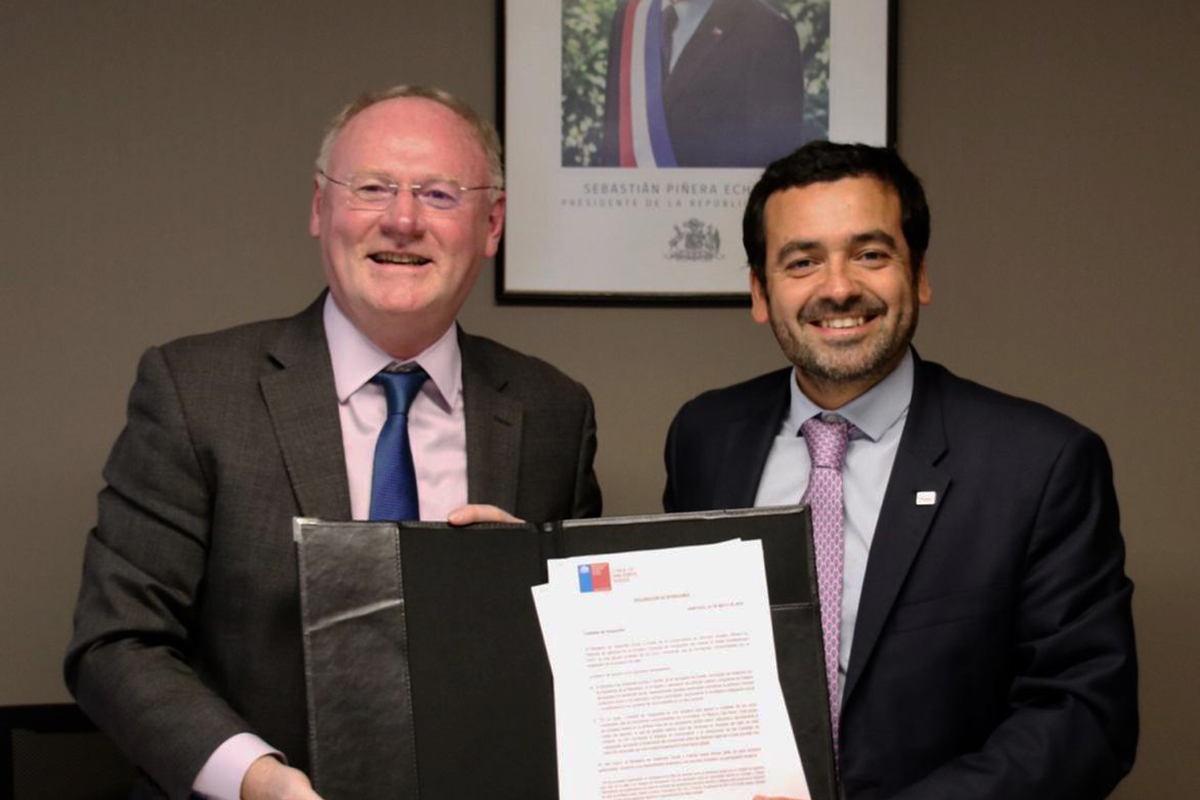 Earlier this spring, Mark McGreevy (left), group chief executive for Depaul International, and Sebastián Villarreal, assistant secretary of social services for Chile, launched Santiago as the Institute of Global Homelessness' last Vanguard City. This initative aims to help 150 cities end street homelessness by 2030. (Image courtesy of Molly Seeley)
Earlier this spring, Mark McGreevy (left), group chief executive for Depaul International, and Sebastián Villarreal, assistant secretary of social services for Chile, launched Santiago as the Institute of Global Homelessness' last Vanguard City. This initative aims to help 150 cities end street homelessness by 2030. (Image courtesy of Molly Seeley)
The houses in Chile’s Vivienda con Apoyo, or “Housing with Support,” program, are two stories each. Newly home to four individuals who have experienced homelessness for more than five years, they are
the first permanent supportive housing initiative in the country. The move-in was coordinated to coincide with Santiago launching as one of the
Institute of Global Homelessness’ Vanguard Cities, an initiative which seeks to help 150 cities end street homelessness by 2030.
The Vivienda con Apoyo houses represent a shift in mindset for Chilean homelessness services and a commitment not only to manage the problem of homelessness throughout the country, but also to end it. President Sebastian Piñera campaigned on a platform that promised new focus and direction for homelessness services, which have swelled in recent years as housing availability shrinks and refugees increasingly run toward the relatively stable, wealthy Chile. Santiago, the country’s capital and largest city, has borne a large part of this burden.
However, leadership from the public and civil sectors believe it is possible to adapt to the inflow and reduce the overall number of people sleeping rough. This will be done through a combination of prevention work, innovative housing policies and improved monitoring methods.
Vivienda con Apoyo is an example of these innovations. An adaptation of the
Housing First intervention, the program seeks to ensure individuals who have experienced homelessness for more than five years will have a safe and secure place to call home as they work to overcome individual hurdles. While in North America one of the key tenants of Housing First is that accommodation is not shared, in Chile it is culturally uncommon to live alone. The model has been adapted to shared houses, with ample room for both parties to maintain privacy but with shared space for socialization.
Over the last decade, Housing First has become one of the most successful long-term interventions for chronically homeless individuals. The idea behind the intervention recognizes the more barriers you remove between an individual and a place to live, the more likely they are to be successful in that housing placement.
Historically, housing programs have had requirements around mental health, sobriety or employment. Those unable to meet those requirements typically were left behind, creating a population deeply entrenched in street life and with few options. Housing First observes it is a herculean task to overcome addiction, address mental instability or maintain steady work while living on the street. These personal hurdles ought to be faced after a client has been placed in housing, and not before.
This is a new idea in Chile, which has historically followed the staircase model of services, beginning with overcoming personal obstacles and ending with independent housing. But with an eye on reducing the number of people sleeping rough, state and civil leadership have recognized the old model wasn’t working.
Karinna Soto, director of the National Homelessness Office in the Ministry of Social Development and graduate of the IGH Leadership Program, instead sought to implement programs which would meaningfully and sustainably move people into housing and out of the already-crowded service system. Soto, who leads Santiago’s “A Place to Call Home” work, is now working in partnership with IGH to improve data quality in the city, and expand innovative new programs to keep the city flexible and adaptable to changing needs on the street. The government is also partnering with a working group of nonprofits and housing providers to ensure that strategies are carried out together, collaboratively.